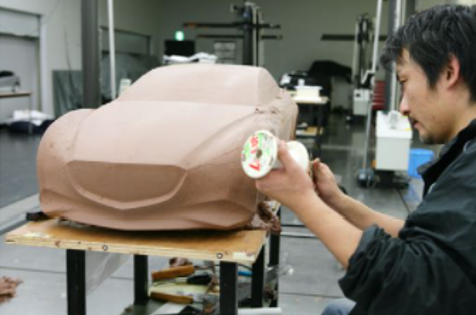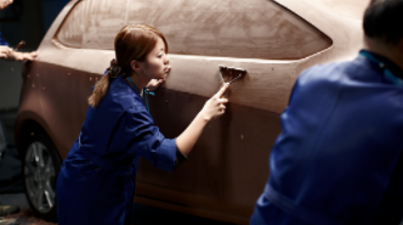The Art of Clay Modelling
The Japanese believe true artistic beauty can only be created by the strength and precision of human hands. That is why Mazda puts so much value on craftmanship – and still uses the art of clay modelling to bring vehicle designs to life.
The impact technology and digital advancements has had on the car industry has changed the way we drive and experience cars every day. For Mazda, cutting edge technology is at the forefront of every car, but when it comes to the design model process of the vehicle, nothing beats creative human touch.

While an initial digital model is created to show the fine details and specific materials of a vehicle, the subsequent clay model is what brings the car’s form and spirit to life – a design and quality that is impossible to replicate digitally.
What is a clay modeller?
A clay modeller transforms the designer’s idea into a three-dimensional object using automotive modelling clay. Through this process, the design moves closer to what it will look like in reality.

This extra step in the vehicle design process is practical as well as aesthetic. Building the clay model allows the design to be fine-tuned with the clay modeller able to spot flaws in the digital render and make suggestions for improvement.
Designers, developers and Takumi clay modellers breathe life into the designs of new Mazda cars. Takumi, which symbolises dexterity and precision, represents a long tradition of master craftsmanship in Japan. At Mazda they work primarily with clay and metal; elsewhere Takumi may work with wood, paper and the straw used for tatami mats. What they all share is a deep commitment to their craft.
Using their unique skills, the Takumi clay modeller sculpt the vehicles in condensed and life-sized formats. What sets them apart from other clay modellers is their expertise and speed. It takes a clay modeller approximately six months to sculpt a life size vehicle, while a Takumi clay modelling expert can create the same vehicle in just two months.
Clay modellers need to hone their skills in different positions for some 20 years before they can reach the Takumi title. There are currently only three Takumi ranked modellers at Mazda in Japan.
A day in the life of a clay modeller Kodo, as Mazda calls its design language, means “soul of motion” in Japanese. It stands for designs that always appear to be moving. A Takumi clay modeller uses the clay to translate the emotion a vehicle is intended to evoke into a three-dimensional sculpture. The form only becomes a digital 3D model when the clay model is perfectly balanced.

The modellers first warm the clay, made up of a special mix of wax, oil, pigment, and filler to 60 °C. The softened material is then applied to the supporting frame before being moulded into the shape of the car. Hands on the clay, transferring energy and depth into the surface’s every nuance.
It is essential for clay modellers to collaborate with digital modellers. In this way, forms created through the art of sculpture can be checked with digital technology. Conversely, the forms refined through digital technology can also be further enhanced through clay modelling. Through this collaborative cycle, a design with the power to capture people’s hearts is turned into a tangible form.

Bringing a car to life
The clay model illustrates the natural, flowing form of a vehicle – as if it’s in motion, even when at a standstill. For Mazda, a car is more than merely a chunk of metal. It is a living creature. When you run your hand over the car’s smooth surface, you’ll feel what the clay modeler perfected: beauty of form, harmonious curves and lines, the expression of freedom and movement made real.
So, when you next see a Mazda, think about the Takumi clay modeller whose mastery, skill, and patience helped make the designer’s vision a reality.
